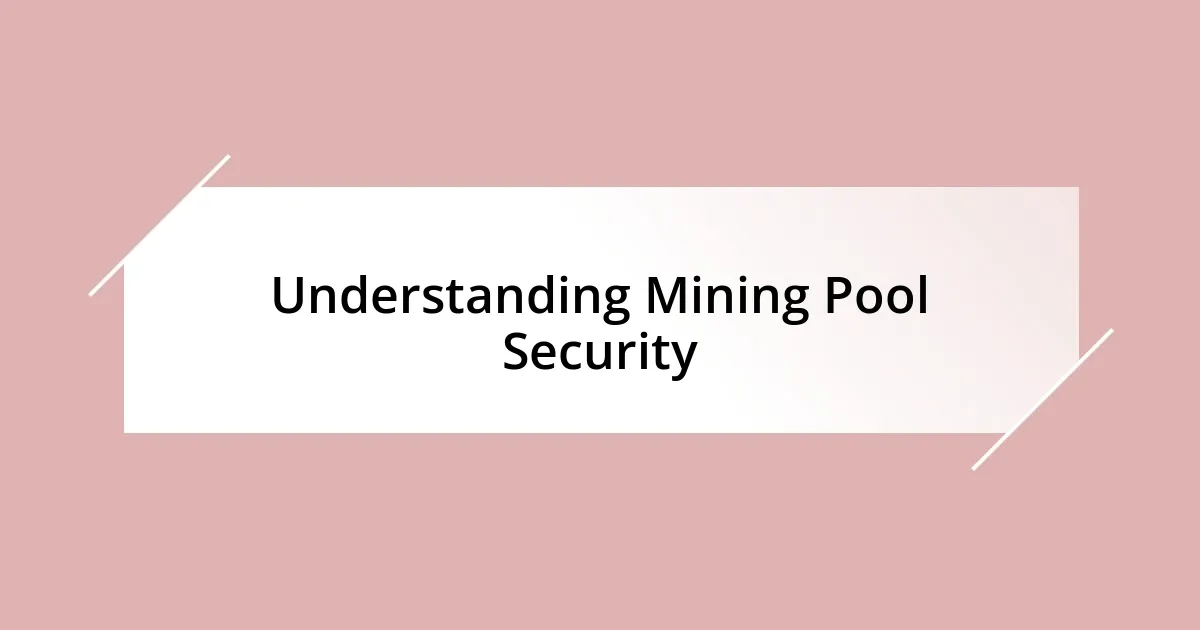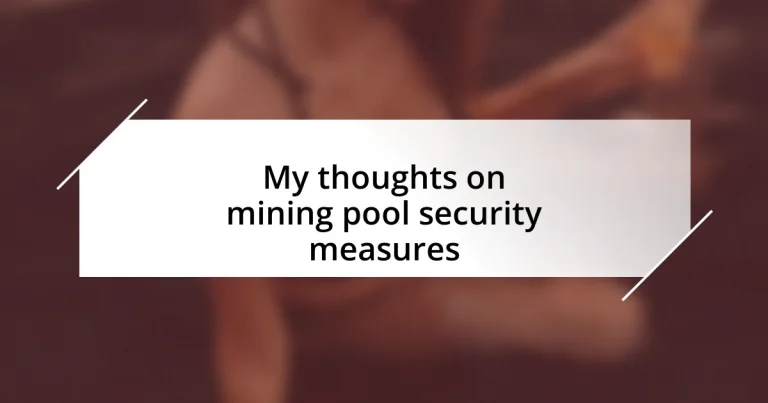Key takeaways:
- Security vulnerabilities in mining pools can exist at various levels; implementing safeguards like two-factor authentication (2FA) is essential.
- Choosing a mining pool requires evaluating their security measures, including transparency about security audits and monitoring for incidents.
- Implementing multi-factor authentication (MFA) significantly enhances account security by requiring additional verification methods.
- Continuous monitoring and regular security audits by mining pools foster trust and demonstrate a commitment to safeguarding user assets.

Understanding Mining Pool Security
When I first jumped into the world of mining pools, the concept of security felt overwhelming. I remember hearing stories about hackers breaching these pools and stealing miners’ rewards, which made me question the safety of my investments. It’s terrifying to think that what you’ve worked hard for could vanish overnight due to a security flaw.
Understanding mining pool security means recognizing that vulnerabilities can exist at various levels. For example, I learned the hard way that not all pools implement two-factor authentication (2FA). The day I neglected to enable it, I felt that familiar pang of anxiety when I heard about a colleague’s experiences with unauthorized access. It’s often the little things that can make a world of difference in securing your assets.
One key aspect I often emphasize is that not all mining pools are created equal in their security practices. Have you ever asked yourself how well your chosen pool protects its members? After researching several options, I found that those with transparent security protocols and active community engagement often ranked higher in trustworthiness. It’s comforting to know that the pool I’m part of prioritizes security, making my mining experience feel much safer.

Evaluating Mining Pool Providers
Evaluating mining pool providers involves delving into more than just their fees and payouts; it’s about understanding their security measures as a whole. When I was selecting a pool, I found that prioritizing providers who openly discuss their security strategies was essential. It’s reassuring to see pools actively sharing their security audits; it shows they’re not only aware of potential threats but also willing to be accountable for protecting their miners.
I recall the nervousness I felt when I first considered mining with a new provider. I meticulously compared factors such as the pool’s reputation, reviews on their security incidents, and how transparent they were about their incident response times. The sense of relief when I finally decided on a reputable pool, one that prioritized an uptime guarantee and extensive backend security, was palpable. It felt like being part of a secure fortress, knowing that my mining rewards were safely safeguarded.
To make an informed choice, I found it useful to visually evaluate different mining pools based on specific criteria. Here’s a comparison table that could guide your selection process.
| Mining Pool Provider | Security Features |
|---|---|
| Provider A | 2FA, Regular Security Audits |
| Provider B | Cold Storage, Transparency Reports |
| Provider C | Multisignature Transactions, Incident Response |

Implementing Multi-Factor Authentication
Implementing multi-factor authentication (MFA) can significantly enhance the security of your mining pool account. From my experience, simply relying on a password isn’t enough; I remember the anxious feeling I had when realizing how easily a password could be compromised. Once I enabled MFA, I felt an immediate sense of relief. Knowing that an additional verification step—like a code sent to my phone—was required to access my account gave me peace of mind.
Factors to consider when implementing MFA include:
– Convenience: Choose a method that is easy for you to use consistently.
– Types of Authentication: Consider options like SMS, email, or authenticator apps for flexibility.
– Backup Codes: Always have backup codes handy in case your primary method fails.
– Regular Updates: Change your MFA method periodically to enhance security further.
– Compatibility: Ensure that your mining pool supports the MFA method you want to use.
When I look back, I can’t stress enough how important it is to grasp the nuances of MFA. The time I faced an unauthorized login attempt was a turning point for me. My quick response, involving MFA, prevented a potential disaster, reaffirming that even small security measures can create a formidable barrier against threats. Making this change felt empowering, as though I had taken control of my digital fortress.

Monitoring for Security Breaches
Monitoring for security breaches is absolutely critical in the mining pool environment. I remember a time when my mining pool provider alerted users about a suspicious transaction. That proactive communication gave me a sense of security, even before I knew the details. It’s moments like these that remind me of the importance of continuous vigilance.
From my perspective, tools like intrusion detection systems can be game-changers. I once had a conversation with a tech-savvy friend who highlighted how these systems automatically analyze network traffic for unusual patterns. It made me wonder, could your mining pool provider be equipped with such technology? If they are, it shows a commitment to safeguarding your assets beyond just basic security measures.
Moreover, I’ve learned that regular security audits can play a vital role in monitoring for breaches. When a pool I was part of underwent an extensive audit, the findings shared kept me informed and reassured. It’s one thing to trust a provider on face value, but seeing the results of audits can reinforce your decision. How can we ever feel fully secure if we don’t understand what vulnerabilities exist? In my experience, transparency in this area strengthens trust between miners and their pools.














